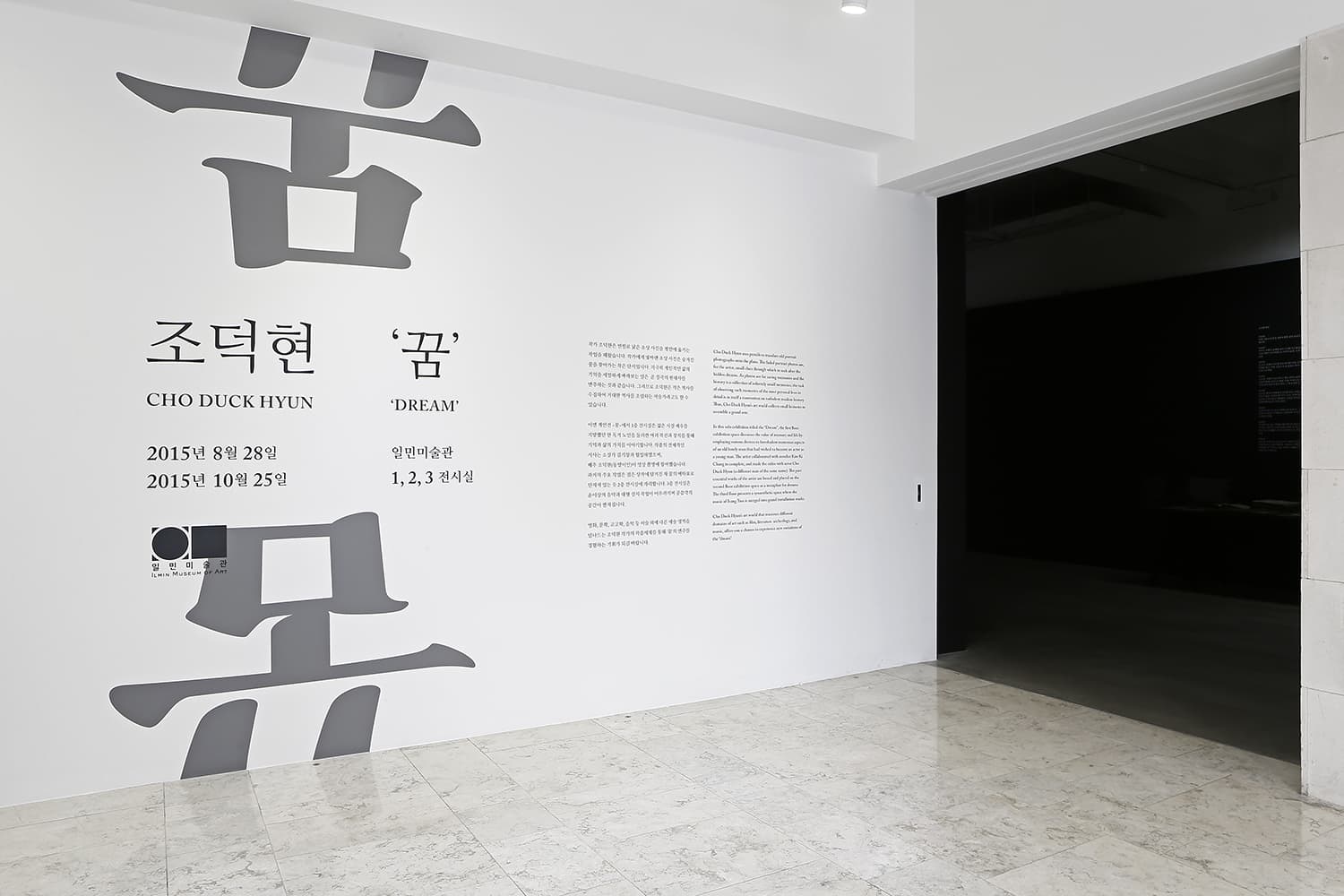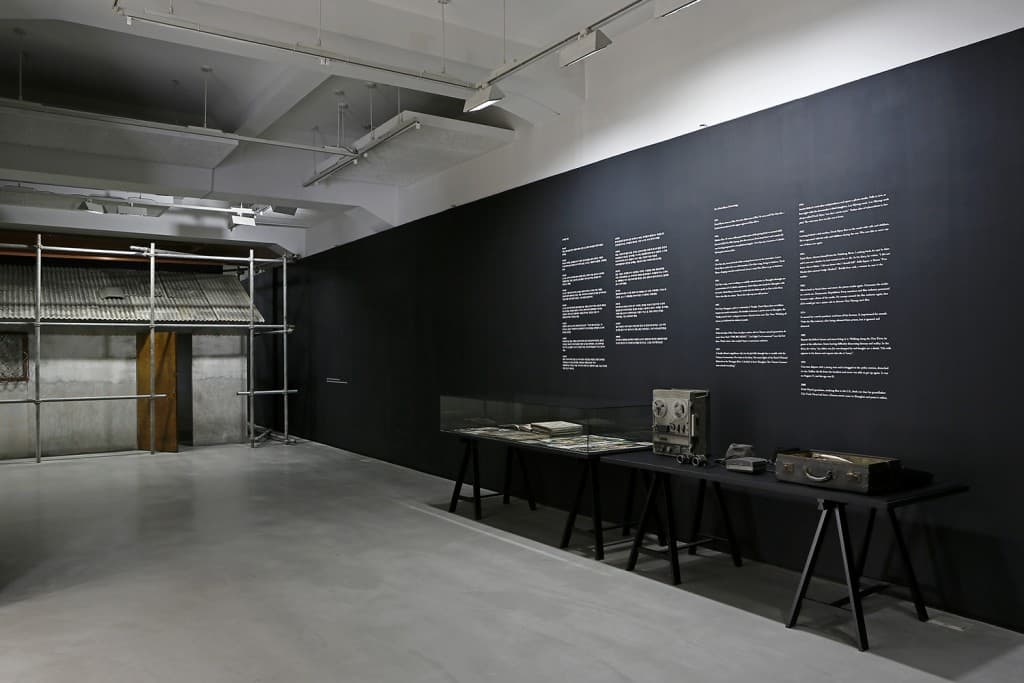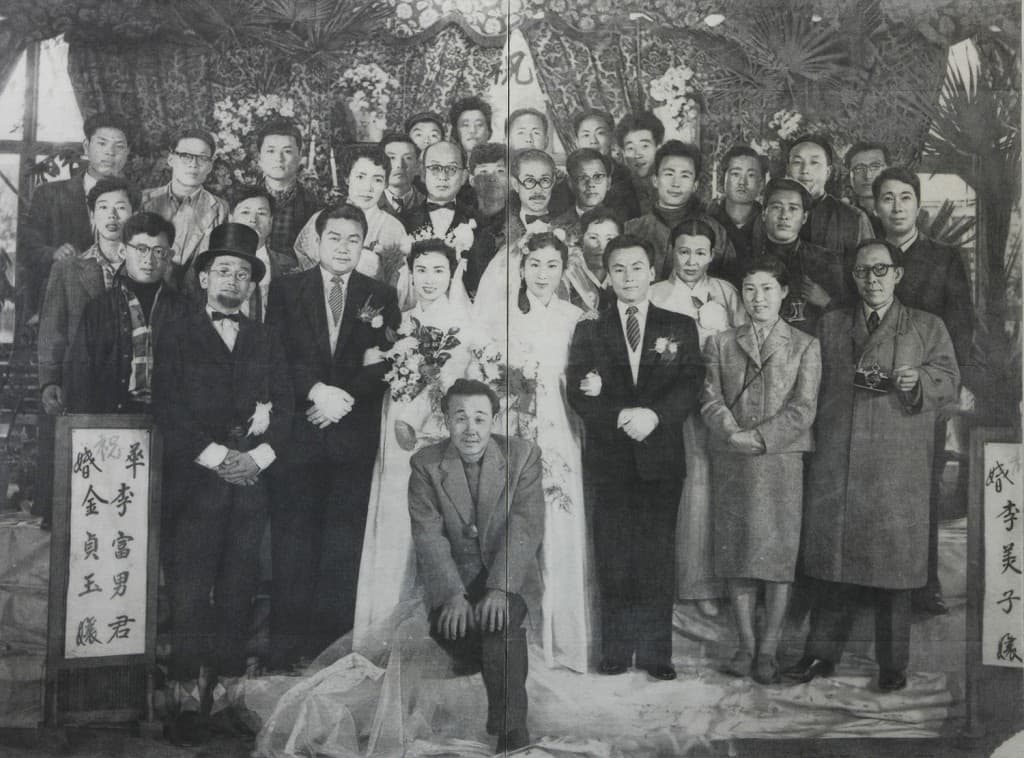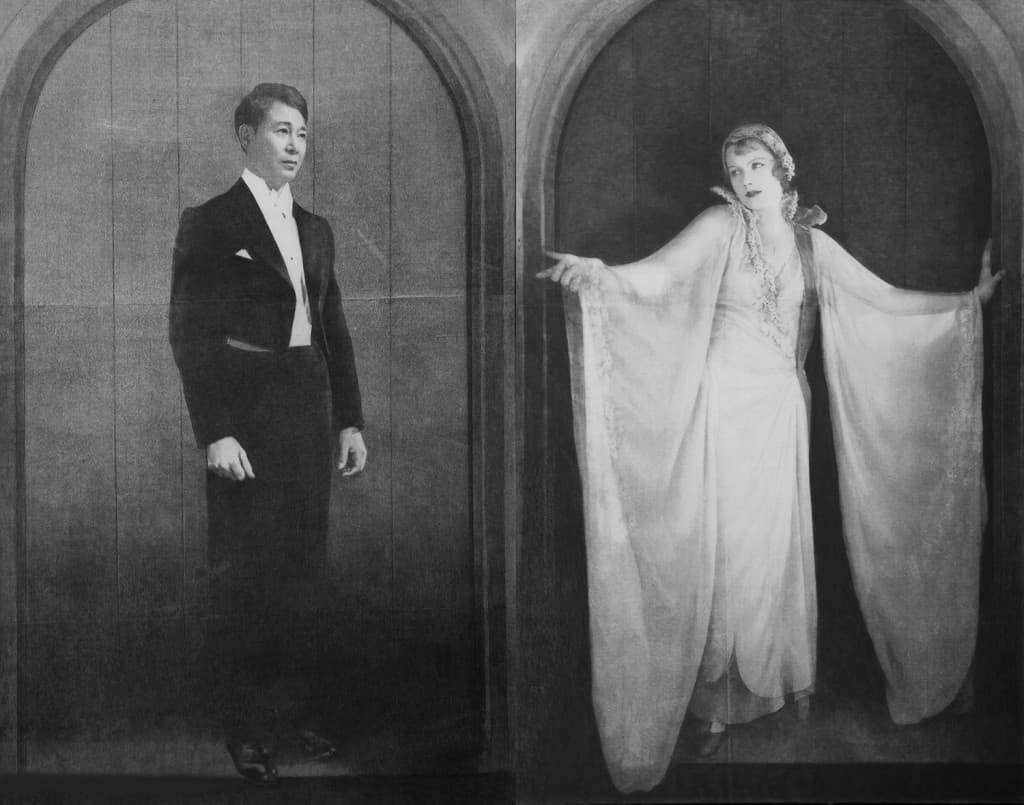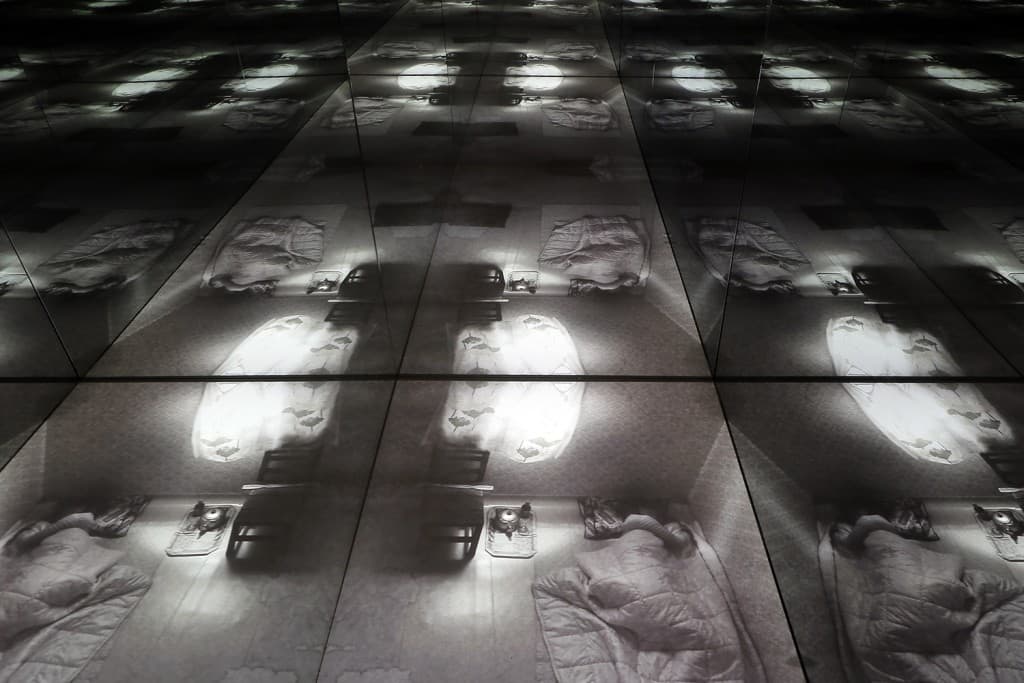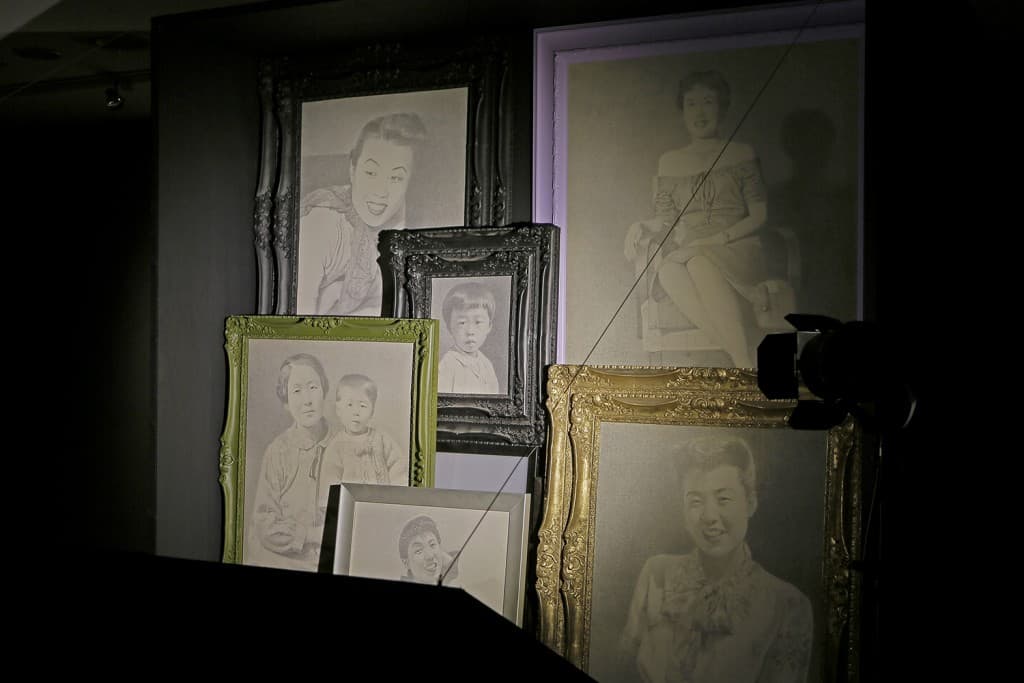조덕현 작가는 오래된 흑백사진을 화폭에 재현하여 한 가족의 역사를 되살리기도 하고, 가상의 역사를 기반으로 새로운 이야기를 만들어내는 발굴 프로젝트 등의 실험적인 시도를 진행했다. 또한 작가는 오랜 시간 동안 문학, 역사, 음악 등 타 장르와의 협업을 적극적으로 시도해왔으며, 보편적인 역사의 흐름 속에 잊혀지는 소수의 인물 혹은 소외된 여성의 근대사를 다루는 등 과거를 복원하고 기억하는 데에 집중해 왔다. 이번 전시는 작가의 신작 프로젝트가 공개 되는 ‘꿈의 정원’, 2000년 이후 다양한 작업의 흐름과 변화상을 볼 수 있는 ‘님의 정원’, 윤이상의 음악이 울려 퍼지는 공감각적 공간 ‘음의 정원’등 세 개의 섹션으로 구성되었다.
꿈의 정원
‘꿈의 정원’은 가상의 한 인물, 즉 작가와 동명이인인 조덕현(1914~1995)이라는 인물의 베일에 싸인 삶을 추적하면서 개인의 서사가 어떻게 거시적 역사를 상징해낼 수 있는지 살피려는 야심 찬 시도이다. 한국 근·현대사를 관통하는 한 남자의 인생과 꿈에 접근하기 위해 가상의 역사를 세밀하게 설정하고, 회화뿐만 아니라 영화와 문학 등 다양한 예술 영역과 함께 호흡하고 있다.
작가 조덕현은 자신 외에 두 명의 동명이인을 전시에 등장시키며 현실과 가상의 모호한 경계 위에서 개인의 역사를 특유의 세밀한 필치로 불러들인다. 1 전시실에 설치되는 ‘집’은 한국의 근대사를 상징하는 가상의 인물을 위해 창조된 공간이다. 그 안에 배치된 사진, 회화 작품, 주인공의 물건, 영상 등을 통해 질곡의 역사 속에서 파란만장했던 한 인물의 삶을 상상해보는 시간을 가질 수 있다.
전시를 위해 특별히 집필된 단편소설 「하나의 강」은 지난해 한 노인의 죽음과 고독을 담담하게 그려낸 장편 소설 『모나코』로 ‘오늘의 작가상(민음사 주최)’을 수상한 소설가 김기창의 협업 작품이다. 이 소설에서 가상의 인물 조덕현은 그의 젊은 시절인 1930년대 ‘올드 상하이’뿐만 아니라, 역사 속에서 흐릿하게 잊혀진 1950년대 한국영화의 전성기에 영화계의 저변에서 활동했던 배우로 묘사되고 있다. 현실과 타협하고 시류에 편승하며 지극히 개인적인 삶을 살아간 가상의 인물 조덕현의 삶은 오히려 굴절과 오욕으로 점철된 한국 근·현대사를 적나라하게 보여주는 거울이다.
신작 프로젝트 ‘꿈의 정원’은 광복 70주년과 맞물려 한 사람의 인생을 통해 삶과 죽음의 가치에 대해 성찰하는 것은 물론, 우리의 과거사를 되짚어보는 의미 있는 기회가 될 것이다.
님의 정원
일민미술관 2 전시실에는 작가의 발자취를 돌아보고 작업의 흐름과 변화상을 한 눈에 아우를 수 있는 ‘님의 정원’이 펼쳐진다.
주류 역사가 관심 두지 않았던 인물들이 가진 미시사적인 순간을 세밀한 필치로 묘사해 현재로 불러들이는 프로젝트(2008), 2차원 평면의 사실적 묘사와 3차원의 오브제를 결합하여 과거의 인물을 복원해 내는 프로젝트(2011), 가상의 국가나 전설을 발굴하는 과정을 통해 역사와 진실 이라는 개념 에 대해 질문하는 ‹구림마을 프로젝트›(2002)등 그 동안 선보였던 작가의 대표작을 한 자리에서 감상할 수 있는 기회를 제공한다.
음의 정원
3 전시실의 ‘음의 정원’에서는 작곡가 윤이상의 음악 중 만년의 작품이자 가장 서정적인 곡이 전시실에 울려 퍼진다. 15m(폭)를 넘는 대형 설치작업으로 음악사뿐만 아니라 질곡의 한국 근·현대사의 상징 중 하나인 윤이상의 예술 세계를 사상이나 역사적인 평가 없이 그 자체로 음미할 수 있도록 한다. 음악과 미술, 시각과 청각이 공명하는 공감각적인 풍경으로 이번 전시의 대단원을 마무리 한다.
참여작가
조덕현
장소
일민미술관 1, 2, 3전시실
주최
일민미술관
연계된 프로그램으로 바로 가기(https://ilmin.org/kr/program/dream-program/)
History and Mirror : an Alibi
Cho Duck Hyun is a representative Korean artist well known for translating photographs into paintings. He selects old black and white photographs and uses pencil to elaborately enlarge them, reviving the full accounts of the figures inside the monochrome. Thus, his work is a composition of the act of reselecting, as an artist, the images that had already been selected and captured by a preceding someone and the act of using the most rudimentary tool, the pencil, to represent what he has closely observed. The conceptual nature of such double actions and the process of revealing the artist’s unconsciousness are in themselves the aesthetic space of dynamics that the artist seeks to create. Employing the labor of hands to retrace an already represented world. The act of concentrating on the moment when the irony of a new creation actually not being new finally transforms into a destiny of not being able to produce anything new, despite all efforts to newly create. The artist often reminisces his father in explaining the reasons behind his ascetic art of obsessively converging toward images of the past. However, behind the obsession with old worn photo images that constantly call forth a universal memory of the past, there also lies the artist’s strategy of yet a different layer.
Let us first go back to the 1990s when the artist was a newly emerging artist of great promise. Postmodernism that had reached Korea at that point was not so much a practical demand of the times to propose a critical perspective on modernism, but rather an attempt to adopt the avant-garde criticism of the West with a little time difference. Bereft of any artistic experience of repeated births and renewals within the tradition of modernism in architecture or art, it was hard to find any mature modernist legacy worthy of criticism in Korea of the 1990s, a country that seemed to be properly joining the ranks of developed nations. Postmodernism in Korea was, so to speak, under the destiny of writing its own history upon a virtual modernism that does not exist. Thus, it could be said that most of the visual artists that had been processed through the arbitrary categorization of postmodernism were presented the opportunity to constantly self-reflect and reference themselves to newly examine the value that they had involuntarily been placed upon.
It is under such circumstances that Cho Duck Hyun started his journey as an artist that writes grand narratives. Consistently hunting through the taxidermied memories presented by old black and white photographs seemed to be the artist’s training for visually apprehending the grand network of history, or an unintentional manifestation of a pure desire to reference the circumstances of the times. For the artist, this task was a means of approaching a clearer truth embraced by each photograph, the framework of fantasy fabricated by the process of representation, and the aesthetic mechanism of the medium called photography. But moreover, this was an act of constructing the alibi of a history narrated through the universality of photographs that is sealed and saved in photo albums kept inside the closets of numerous Jane and John Does.
It was from the series of excavation projects inaugurated in 2000 that Cho’s art world came to more earnestly call forth history. Participating in the “Earth Art Festival” held in Jeollanam-do Yeongnam in 2000, the artist presented his “Gurim Village Project” of creating a group of dogs in copper to bury and later excavate. This project was presented again at the Jeu de Paume in Paris under the title “Dog of Ashkelon-Journey to Alien God”, and wrapped up in 2002 as the project “Entering Yiseoguk”. Through this journey of about two years, the artist takes on the role of a researcher that excavates the images of history (and their corresponding virtual truth) through burying and digging up the dogs designated as excavated relics. Promoting the secondary task of proclaiming that the history passed on through education could in fact be easily fabricated or amended, or, in other words, to announce that even the value that serves as the core of civilization is a variable object, the artist writes a probable narrative and reenacts an objective research methodology of excavation.
The transfer of past image-memories onto a grand history is also related to the scope that paintings occupy in Cho’s art. Having been absent from the public eye during the phase of excavating dozens of dogs as an attempt to touch the abyss of universal human memory, paintings were soon called back; that is, instead of the dogs that had functioned as the icon of virtual relics and symbol system, the artist started to designate his unique painting of drawing photographs as his object of excavation. With “Flash Back”, he transferred the memories of a photo studio in Japan that has been operated over seven generations onto a canvas, buried it under the waters of the 350-year-old lake in the village, to later fish out and display. Performed in New Zealand, “Dark Water” presented the process of storing in big boxes the paintings that portray marriage ceremonies of various races to represent an immigrant society, burying them in the sea, and fishing them out. This process of designating the media of old photos and their portrait paintings as the bowls to hold something with and perceiving them as fragments of history could ultimately be comprehended as a totalizing process of constantly aggregating the fragments into a larger frame.
The task of reconstructing history is therefore, for the artist, an act of creation rather than research. In selecting from the infinite image database that constitute the past, whether the image could be presented as an artwork that meets the artist’s subject or not took precedence over its certain (original) historical context. Significant to the artist was not proving the historical truth, but the issue of how history would not lose its authenticity while refracting through the artist’s aesthetic prism; or, in other words, the issue of how he could reconstruct history through detailed set-ups. To strengthen his story, the artist commissioned oral literary academics and remarkable novelists of his time to construct the background narrative of his art and positioned himself at an omniscient viewpoint from which he could observe the narrative at one glance. Rather than walking on the framework of history, he completely distances from it to observe history itself as a passed down fable or a traditional narrative with characters, incidents, conflicts, and backgrounds.
Following such flow of the artist’s oeuvre, it is not difficult to see that the Dream presented at the Ilmin Museum of Art is his mellow challenge of introducing a new twist on this art. First, the content of the project has greatly narrowed it gap with the real world. Unlike the past projects based on narratives of faraway times and spaces, Dream is based on modern Korea, a setting that is close to both the artist and the audience. Would it be that the specific coordinates implied by various settings of the exhibition, such as the symbolism of the Gwanghwamun intersection where the Ilmin Museum of Art stands, or that of the 70th anniversary of independence, had triggered a more specific sense of historical vocation for the artist? However, aside from a mere representation of history symbolized through a virtual character, this exhibition seeks an encounter with film and literature to present a style that is thoroughly different from the preceding episodes.
In Dream, the artist starts a journey away from the methodology of processing real objects inside photographs toward a more explicit fantasy. First, he took on the illusion of film, something that is not real and yet designed closest to reality, as his most crucial material. Setting the hero of this exhibition, a virtual Cho Duck Hyun, as someone that had worked in film industry, the artist collected elements of the prime 1950s of Korean films, observed the fancy cinematic space of 1930s Shanghai, excerpted a scene from a classic film beloved during the modernization days of Korea and drew actor Cho Duck Hyun’s face on it. Based on a rather dry narrative by novelist Kim Ki Chang, the space of nostalgia where the virtual Cho Duck Hyun yearns for the short-lived moments of his life is filled with the artist’s paintings that have become softer and donned darker shades by employing Korean traditional paper.
The pseudo-diorama built inside the gallery is designated as the last space of tragedy of a man that aged to die alone. As an act of representing a virtual tragedy through the most realistic imagination, such feat meets the essence of films. This is because films are not about representing the reality, but are an assemblage of techniques for producing new images that appeal to the images of reality already familiar to the public. Such cinematic approach functions as a means of deducing universal images that “solitary” and “old man” imply, as was the case with the virtual Cho Duck Hyun, rather than focusing on the specific details that individual lives bear. It is thanks to this that the gap between the real life and the life that seems real is reborn as a refreshing space of logic that has been processed through an imagination to be represented through the keywords of “poverty” and “tragedy”.
The video that serves as the most meticulous center of the project’s audio and visual portrays the virtual Cho Duck Hyun lying down or moving around in his room right before his death. As the video was filmed from a bird’s-eye view, the audience is perfectly positioned as observers. The old man thus strictly remains as an object of observation and not an object of empathy. The image of such old man is designed to be infinitely expanded through mirrors, presenting not just the destiny of a single man represented in an exhibition, but the prototype of sentiments that most Koreans living through the 20th century would have held on to. However, the display mechanism of employing mirrors endlessly shifts spatial perception, leading one to wonder about the real existence of the object that is reflected on the mirror. Such choice has allowed the artist to open another exit door that heads toward a direction that is different from his previous works of portraying real figures in history and keeping an adequate distance.
This project Dream is thus Cho Duck Hyun’s grand self-portrait. The process of inventing a virtual figure of the same name as himself and casting a real actor to play that man was in fact the artist’s means of designating the exhibition itself as a grand mirror, a tool through which to reflect himself with. In other words, just as the virtual “Cho Duck Hyun” is a compressed symbol of the ups and downs of the 20th century, the artist has constructed a system with which to symbolize the rare and complex history of modern Korea and uses it as a mirror to observe himself with.
Under such developments, the artist falls deeper into nostalgia, deeper than when he had rummaged through the past with photographs. The act of surveying the makeup of an era that is presumed to have enjoyed richness of culture was specified through the deeds of investigating the film industry of Shanghai, the once Hollywood of Asia, and studying the role that Korean film of the 1950s had played. The beautiful past that lives in memory is then naturally processed through the piteous and painful filters of reality represented in the exhibition space, eventually leaving multi layers of meaning on the audience. Also, as the artist himself had mentioned, this is an act of sowing seeds from which roots of ideas for the “Old Shanghai” or “Hollywood-Epic” series could develop.
Standing in front of history, what choice would the artist be able to make? What does is mean for an artist to gather fragments of history and toss them inside an exhibition space? Faced with such questions, Cho Dock Hyun deliberately detours a completion of his art’s inner logic to avoid the mass of historicity, and instead stands right in front of history to condense an energy for finishing its corresponding narrative. It is through that energy that the artist dreams of an art that conveys narrative, calculates the logical development of narratives reflected in art, and freely checks the open possibilities to enjoy ample play.
Venue
Gallery 1, 2, 3
Organized by
Ilmin Museum of Art
Go to the linked program(https://ilmin.org/kr/program/dream-program/)

